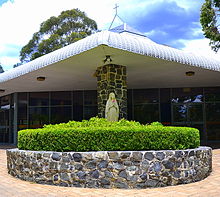Waitara is a suburb in the Upper North Shore region of Sydney, in the state of New South Wales, Australia 19 kilometres north-west of the Sydney central business district, in the local government area of Hornsby Shire.
| Waitara Sydney, New South Wales | |||||||||||||||
|---|---|---|---|---|---|---|---|---|---|---|---|---|---|---|---|
 Waitara Station | |||||||||||||||
 | |||||||||||||||
| Population | 7,837 (2021 census)[1] | ||||||||||||||
| Postcode(s) | 2077 | ||||||||||||||
| Elevation | 187 m (614 ft) | ||||||||||||||
| Location | 18 km (11 mi) north-west of Sydney CBD | ||||||||||||||
| LGA(s) | Hornsby Shire | ||||||||||||||
| State electorate(s) | Hornsby Ku-ring-gai | ||||||||||||||
| Federal division(s) | Bradfield | ||||||||||||||
| |||||||||||||||


History
editWaitara is a word in the Māori language that means hail, pure water or hail, wide steps. (There is also a town in New Zealand named "Waitara".)[2] The suburb takes its name from the Waitara River in New Zealand, where Australian troops fought as Imperial volunteers during the New Zealand Wars.
European settlement
editMyles McRae once owned land in Southern Sydney, near Hurstville. When he sold that land to a development company, the manager used the name Waitara for the subdivision project. McCrae later bought land near Hornsby and when the railway station opened in 1895 he suggested the name Waitara, which was formally adopted.[2]
Waitara Post Office opened on 1 October 1913 and closed in 1986. Waitara East Post Office opened on 1 June 1966 and closed in 1994.[3]
Transport
editWaitara railway station is on the North Shore railway line of the Sydney Trains network. It was originally known as Sandy Bank.
CDC NSW operates five bus routes through the suburb of Waitara:
Commercial and community facilities
editWaitara is a centre for all things automotive, car dealerships both new and used, car maintenance and smash repairers.
Waitara has just one hotel, the Blue Gum Hotel. There has been a hotel on the site since 1884, but two fires have destroyed the older buildings. The current building dates from 1962.[9]
Waitara also has a Rugby League Club, called Asquith Rugby League Club, and a gym, called Millennium Health Club.
Police and Community Youth Clubs run a Performing Arts Centre in Edgeworth David Avenue (the latter is named after the scientist Edgeworth David).
Schools
edit- The public school is Waitara Public School, which has two O.C (opportunity class) classes. (Located in Wahroonga).
- The Catholic school is Our Lady of the Rosary Primary School. It was established in approximately 1918 and was located on the Pacific Highway opposite the railway station. It has since been relocated to Yardley Avenue.
Churches
edit- Our Lady of the Rosary Catholic Church was originally situated on the Pacific Highway opposite Hornsby railway station. It was later relocated to 27 Yardley Avenue. It has since become the cathedral church of the Roman Catholic Diocese of Broken Bay and is known as Our Lady of the Rosary Cathedral, Waitara. It is the namesake of the hymn tune Waitara.
- Waitara is home to a large Korean Catholic Community Church,[10][11] which has produced the youth activity group WCKYS. The latter can be divided into three subgroups: Kerygma, J.O.Y. and Youth Legion of Mary. Kerygma group organises the youth mass, while J.O.Y. (Jesus Others and You) consists of teachers of Waitara Korean Sunday School.
- The Anglican Church of Waitara (All Saints) is located on the corner of Burdett Street and Palmerston Road. In addition to church services, there are a number of other events during the week including ESL classes, children's groups, youth groups and Bible studies.[12]
- The Seventh-day Adventist Church, located at the corner of Park Avenue and Alexandria Parade, was established in 1903.[13]
Population
editThe 2021 census community profile for Waitara revealed roughly equal proportions of men (48.4%) and women (51.6%) in a total population of 7,837. The median age of the Waitara population was 36 years of age, which was similar to the national median of 38. The most common ancestries in Waitara were Chinese 25.5%, Indian 17.0%, English 12.3%, Australian 10.3% and Korean 4.8%. 31.4% of people were born in Australia, the next most common countries of birth were India 16.2%, China 14.7%, South Korea 3.6%, Philippines, 3.5% and Iran 3.4%. 30.6% of people spoke only English at home. Other languages spoken at home included Mandarin 15.5%, Hindi 7.0%, Cantonese 6.2%, and Persian (excluding Dari) 3.8%. The average household had 2.4 people. The most common responses for religion were No Religion 34.3%, Hinduism 19.2%, and Catholicism 13.6%.[1]
References
edit- ^ a b Australian Bureau of Statistics (28 June 2022). "Waitara". 2021 Census QuickStats. Retrieved 30 January 2024.
- ^ a b The Book of Sydney Suburbs, Compiled by Frances Pollon, Angus & Robertson Publishers, 1990, Published in Australia ISBN 0-207-14495-8, page 262
- ^ Phoenix Auctions History. "Post Office List". Retrieved 21 January 2021.
- ^ "| transportnsw.info". transportnsw.info. Retrieved 4 May 2024.
- ^ "| transportnsw.info". transportnsw.info. Retrieved 4 May 2024.
- ^ "| transportnsw.info". transportnsw.info. Retrieved 4 May 2024.
- ^ "| transportnsw.info". transportnsw.info. Retrieved 4 May 2024.
- ^ "| transportnsw.info". transportnsw.info. Retrieved 4 May 2024.
- ^ Blue Gum Hotel – Waitara Hornsby Sydney
- ^ Our Lady of the Rosary, Waitara website
- ^ Diocese of Broken Bay Korean Community website
- ^ Waitara Anglican Church
- ^ Waitara Seventh-day Adventist Church
External links
edit- Joan Rowland (2008). "Waitara". Dictionary of Sydney. Retrieved 29 September 2015. [CC-By-SA]